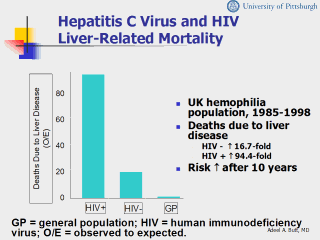| front |1 |2 |3 |4 |5 |6 |7 |8 |9 |10 |11 |12 |13 |14 |15 |16 |17 |18 |19 |20 |21 |22 |23 |24 |25 |26 |27 |28 |29 |30 |review |
 |
Background:
Little has been defined regarding the magnitude or time course of the effect
of chronic HCV infection on mortality. Objective: Evaluation of mortality from liver cancer and liver disease in the entire UK hemophilia population to determine effects of persistent HCV infection. Methods: Data from a cohort of 4865 men and boys with hemophilia who received treatment between 1969 and 1985 with blood product associated with a high risk for HCV infection were analyzed to determine mortality from liver cancer and liver disease. The cohort was followed from first reported exposure to January 1, 1993. Results: Mortality in the cohort was 16.7 times higher than in the general population for liver disease and 5 to 6 times higher for liver cancer. The cumulative risk for death from chronic or unspecified liver disease or from liver cancer among those with severe hemophilia but without HCV infection was 1.4%. For those with first recorded exposure at age 25 years, age 25 to 44 years, and age >45 years, the cumulative risks were 0.10%, 2.2%, and 14.3%, respectively. The corresponding cumulative risks for those with hemophilia and HIV infection were 3.8%, 17.1%, and 18.7%, respectively; the risk at all ages was 6.5%. While age-standardized all-cause mortality was stable from 1969 to 1984 in those with severe hemophilia, it increased from 1985 to 1992 in both those with and without HIV infection. Among those without HIV infection, the increase in all-cause mortality was largely due to chronic or unspecified liver disease or liver cancer in men aged 45 years or older. Conclusion: The increasing risk for mortality in subjects with hemophilia with and without HIV infection probably results from HCV infection. References Darby SC, Evart DW, Glangrande PL, et al, for the UK Haemophilia Centre Directorsí Organisation. Mortality from liver cancer and liver disease in haemophilic men and boys in UK given blood products contaminated with hepatitis C. Lancet. 1997;350:1425-1431. |